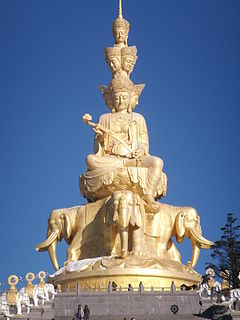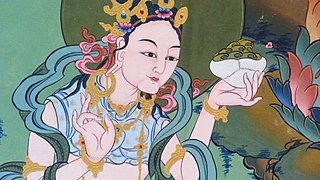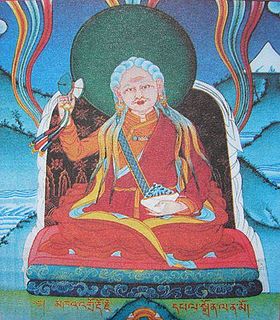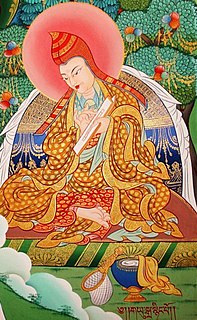
Padmasambhava, also known as Guru Rinpoche and the Lotus from Oḍḍiyāna, was an tantric Buddhist Vajra master from India who may have taught Vajrayana in Tibet. According to some early Tibetan sources like the Testament of Ba, he came to Tibet in the 8th century and helped construct Samye Monastery, the first Buddhist monastery in Tibet. However, little is known about the actual historical figure other than his ties to Vajrayana.

Tashi Paljor, Dilgo Khyentse Rinpoche was a Vajrayana master, scholar, poet, teacher, and recognized by Buddhists as one of the greatest realized masters. Head of the Nyingma school of Tibetan Buddhism from 1988 to 1991, he is also considered an eminent proponent of the Rime tradition.

Samantabhadra is a bodhisattva in Buddhism associated with practice and meditation. Together with Gautama Buddha and the bodhisattva Mañjuśrī, he forms the Shakyamuni Triad in Mahayana Buddhism. He is the patron of the Lotus Sutra and, according to the Avatamsaka Sutra, made the ten great vows which are the basis of a bodhisattva. In Chinese Buddhism, Samantabhadra is known as Pǔxián and is associated with action, whereas Mañjuśrī is associated with prajñā. In Japan, this bodhisattva is known as Fugen, and is often venerated in Tendai and Shingon Buddhism, and as the protector of the Lotus Sutra by Nichiren Buddhism. In Sri lanka, he is known as Sumana Samana Deviyo and is regarded as the guardian of the island of Sri Lanka.

The Nyingma school is the oldest of the four major schools of Tibetan Buddhism, founded by Vajrayana revealer Guru Padmasambhava. "Nyingma" literally means "ancient," and is often referred to as Ngangyur, "school of the ancient translations" or "old school". The Nyingma school is founded on the first translations of Buddhist scriptures from Sanskrit into Old Tibetan in the eighth century, during the reign of King Trisong Detsen. The Tibetan alphabet was created for this endeavour, and the classical variety of the Tibetan language standardised.

Yeshe Tsogyal (also known as "Victorious Ocean of Knowledge", "Knowledge Lake Empress", , or b.early 8th cent. - d.mid 8th cent., attained enlightenment in her lifetime and is considered the Mother of Tibetan Buddhism. Yeshe Tsogyal is the highest female in the Nyingma Vajrayana lineage. Some sources say she, as Princess of Karchen, was either a wife or consort of Trisong Detsen, emperor of Tibet, when she began studying buddhism with Padmasambhava, who became her main karmamudrā consort. Padmasambhava is a founder-figure of the Nyingma tradition of Tibetan Buddhism, and is considered as a second buddha of our era. She is known to have revealed terma with Padmasambhava and was also the main scribe for these terma. Later, Yeshe Tsogyal also hid many of Padmasambhava's terma on her own, under the instructions of Padmasambhava for future generations.

Chokgyur Lingpa or Chokgyur Dechen Lingpa (1829-1870) was a tertön or "treasure revealer" and contemporary of Jamyang Khyentse Wangpo and Jamgon Kongtrul. Regarded as one of the major tertöns in Tibetan history, his termas are widely practiced by both the Kagyu and Nyingma schools.
Chokgyur Lingpa was the "manifestation," meaning the reincarnation, of King Trisong Deutsen's son, Prince Damdzin. Another of his former lives was the great terton, Sangye Lingpa, who revealed the Lama Gongdu. Chokgyur Lingpa was the last of the 100 major tertons. He was the owner of seven transmissions and is regarded as the universal monarch of all tertons. One of the reasons for this is that no other terton has revealed a teaching that includes the Space Section (Longdé) of Dzogchen. There are several Mind Section (Semde) revelations and all major tertons have revealed the Instruction Section (Mengagde), but only Chokgyur Lingpa transmitted the Space Section. This is why the Dzogchen Desum is considered the most extraordinary terma that he ever revealed. Chokgyur Lingpa's main consort was Dechen Chodron and Padmasambhava predicted that his three children would be emanations of the three family lords: Avalokiteshvara, Manjushri and Vajrapani. I don't like saying this, for it may sound like I'm bragging about my family line, but such a prophecy does exist. The Manjushri emanation was supposed to be Wangchok Dorje, the Avalokiteshvara emanation Tsewang Norbu and the Vajrapani emanation my grandmother, Konchok Paldron.

Ayu Khandro, also known as Dorje Paldrön, lived from 1839 to 1953. She was a practitioner, yogini, and terton of Tibetan Buddhism in Eastern Tibet. An accomplished Dzogchen meditator, she is renowned for her extensive pilgrimages throughout Tibet, long periods of dark retreat practice, the gongter of the practice of the yidam Senge Dongma, various forms of Chöd, and her lifelong dedication to spiritual practice.
Longdé is the name of one of three scriptural divisions within Dzogchen, which is itself the pinnacle of the ninefold division of practice according to the Nyingma school of Tibetan Buddhism.

Longchen Nyingthig is a terma, revealed scripture, of the Nyingma school of Tibetan Buddhism, which gives a systematic explanation of Dzogchen. It was revealed by Jigme Lingpa (1730-1798).
Mañjuśrīmitra was an Indian Buddhist scholar. He became the main student of Garab Dorje and a teacher of Dzogchen.
In Tibetan Buddhism and Bon, Menngakde, is the name of one of three scriptural and lineage divisions within Dzogchen.
Shri Singha was the teacher of Padmasambhava, of Vimalamitra, and of Vairocana. He was a principal student and dharma-son of Mañjuśrīmitra in the Dzogchen lineage, and is credited by the Nyingma school with introducing Dzogchen to Tibet.
According to the Nyingmapa tradition of Tibetan Buddhism, the Dzogchen masters Manjushrimitra and Shrisimha were already active in the Tantric milieu in India independently. However, Manjushrimitra, a learned scholar of Brahman origin, was evidently an adherent of the Yogachara school before his becoming a disciple of the mysterious Prahevajra or Garab Dorje from the country of Uddiyana. It should also be recalled that his disciple Shrisimha was said to have born and resided for some time in China before coming to India. And that the latter's disciple Vimalamitra visited China before and after he came to Tibet and transmitted the Dzogchen teachings to his disciples at Samye Monastery.
sNub-Ben Namkha'i Nyingpo is counted amongst the principal "twenty-five disciples" of Padmasambhava. sNub Ben Namkha'i Nyingpo was a realized practitioner of Śāntarakṣita’s tradition of Sutrayana "gradualist" Mahayana Buddhism as well as simultaneously being one of the most accomplished Tibetan practitioners of the East Mountain Teaching of Chan Buddhism, which transmits the "subitist" tradition of Mahayana Buddhism.
Yeshe is a Tibetan term meaning wisdom and is analogous to jnana in Sanskrit. The word appears for example in the title of the Lamrim Yeshe Nyingpo, a Vajrayana Buddhist sacred scripture that records oral teachings of Padmasambhava in the 9th century, and in the name of Yeshe Walmo, a deity of the Tibetan religion of Bon. It is used as a unisex given name by Tibetans and Bhutanese people, also spelled Yeshey, Yeshay, or Yeshi.
In Tibetan Buddhism, specifically in the literature and practice of Dzogchen, the seventeen tantras of the esoteric instruction cycle are a collection of tantras belonging to the textual division known as the "esoteric instruction cycle".

The Yarlung Valley is formed by the Yarlung Tsangpo River and refers especially to the district where it joins with the Chongye River, and broadens out into a large plain about 2 km wide, before they flow north into the Yarlung Tsangpo River or Brahmaputra. It is situated in Nedong County of Lhokha Prefecture in the Tibet Autonomous Region of China. The capital of Lhokha Prefecture, Zêtang, in the Yarlung Valley, is one of Tibet's largest cities, and is 183 km southeast of Lhasa.

Yudra Nyingpo was one of the chief disciples of Vairotsana and one of the principal lotsawa "translators" of the first translation stage of texts into Tibetan.
Keith Dowman is an English Dzogchen teacher and translator of Tibetan Buddhist texts.

Nyêmo Chekar monastery ཉེ་མོ་ཆེ་དཀར་དགོན། is a small Buddhist monastery of the Bodongpa tradition in Nyêmo County, Lhasa, Tibet. It is known for its mural paintings of reincarnations of the Samding Dorje Phagmo.
Atsara Salé was an 8th-century practitioner of Vajrayana Buddhism from South India. A student of both the dakini Yeshe Tsogyal and the great master Padmasambhava, the co-founders of Tibetan Buddhism. He is known for being one of Yeshe Tsogyal's main consorts along with Padmasambhava, and for writing one of Yeshe Tsogyal's biographies.











